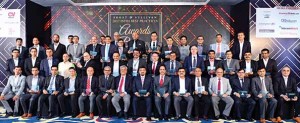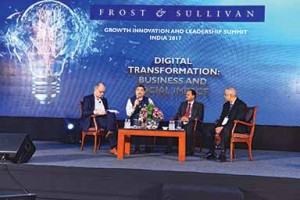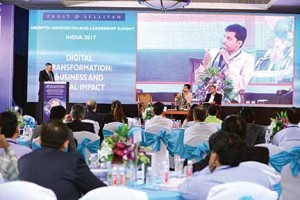The Frost & Sullivan GIL India Summit 2017 recognised successful digital strategies to transform mobility.
Story by:
Ashish Bhatia
As smart phones and similar such gadgets pouring upon the humankind, bringing information to the finger tip, many organisations are leveraging different digital strategies to help their business platforms scale new heights of success. Reflecting upon such strategies, the Frost & Sullivan Growth Innovation & Leadership (GIL) India Summit 2017 saw industry leaders and senior Frost & Sullivan executives speak about mobility transformation. They emphasised upon India’s evolution as a global powerhouse in the day-long event. Marking the ninth edition of GIL India Summit, the event saw CxOs stress upon disruptive innovations as catalysts, and how they are transforming the way industries function. Announced Aroop Zutshi, Global President & Managing Partner, Frost & Sullivan, that technology is proving to be an enabler as well as a disrupter. He mentioned, “Organisations are digitally reworking their business initiatives to accomplish digital transformation, which is the need of the hour.” With technology and growth opportunities finding mention, a discussion on digital readiness of organisations proved to be of interest. Deliberation on Internet of Things (IoT) took place. It was deemed as a driving force for innovations. Said Zutshi, “There is a need to take advantage of data. With linear growth unacceptable, the need for companies is to look at top-line growth rather than focus on attaining bottom-line growth as a long term strategy.” “Digital transformation is catalysing innovation, productivity and growth,” he quipped.
Underlining key benefits of integrating disruptive technologies, the Summit 2017 saw Dr. Seshu Bhagavathula, Chief Technology Officer, Ashok Leyland, speak about transformational change. He emphasised upon the proliferation of platform-based business models and ecosystems, and how they are unlocking an immense potential for growth to gain a competitive advantage. Linking the ability to digitally re-imagine the business, Dr. Bhagavathula said, “Aggregator model will be obsolete over time. The value of their service will diminish. This will create a need for an aggregator-less mechanism.” Emphasising on an apparent shift in the ‘value chain’, Dr, Bhagavathula cited the example of people renting cars rather than buying them. “It is service that is beginning to figure at the top,” he averred. Dr. Bhagavathula opined that business models will undergo transformation, and reliance on middle men will cease. Touching upon multi-modal transportation and zero emission vehicles as agents of change, Dr. Bhagavathula announced that electric trucks with a range of 500 km to 600 km will mark the future.
Faster growth
Calling upon the need for traditional business models to collaborate, Jaspreet Bindra, Senior Vice President – Digital Transformation, Group Strategy Office, Mahindra & Mahindra Ltd., said that consolidation will continue to take place. “Platform-based businesses are scaling up faster than the conventional asset led businesses. The need is to sell experience over products. Customer preferences are changing. They are forcing business models to change. Companies that sell experience will flourish.” Pointing at mobile apps. as part of the core business, and not in isolation, Bindra stated that there was a need to modify strategies. He emphasised upon the digital platform developed by Mahindra for farmers, what with 35 per cent of the company’s revenues coming from rural India. Defining the rate of data transformation as exciting, Peter Gartenberg, General Manager, Enterprise Partner Group (EPG), Microsoft India, announced that the technology which Uber is using is not new. “Its success can be credited to the way the cab aggregator has integrated data on a common platform,” mentioned Gartenburg. He informed that the use of data in India is moderate, and should rise. Terming the need to engage customers, empower employees, optimise operations and transform products as the key areas an organisation should focus upon, Gartenburg said, “IoT, augmented reality, and quantum computing are the most relevant technologies. Digital transformation isn’t just catchy, it’s catching on.”
Drawing attention to a study by Frost & Sullivan, ‘Mapping Digital readiness of organisations and urging them to embrace Disruption’, Vidya S Nath, Senior Director, Digital Media, Global Innovation Centre, Frost & Sullivan, expressed, “Digital transformation to adapt technology and business models is a critical mission for Indian enterprises. The digital market transformation is valued at USD 45 billion. Close to 32 per cent of the total digital spend on manufacturing in 2016 was spent on cloud. Of the rest, 26 per cent was spent on mobility, 18 per cent was spent on analytics, one-per cent was spent on social, and the remaining 23 per cent was spent on miscellaneous activities.” On the topic of IoT leading to unanticipated innovation, Juergen Hase, Chief Executive Officer, Unlimit (A Reliance venture), averred, “IoT is driving new customer, and will lead to intelligent industry solutions. IoT is expected to drive trillions of dollars in opportunity for the IT industry.” Stating that truck and bus manufacturers will need to build intelligent ecosystems and partnerships, Dr. Bhagavathula mentioned that missing standardisation in devices will lead to challenges. Upon the challenge to integrate technologies, Benoy C.S, Director & Business Unit Head – Digital Transformation, Frost & Sullivan, said, “I expect organisations to earmark 40 to 50 per cent of their overall budgets for security going forward.”
Market push and ground realities
About the challenge of going digital, Dr. Rishi Mohan Bhatnagar, President, Aeris India, said that they were operating two trucks in Chattisgarh and Srinagar. “In both the regions, we are facing connectivity challenges, which highlights the fact that digitisation is at a nascent stage in the country.” Averred Dr. Bhagavathula, “To adopt advanced technologies calls for huge sums of money. To achieve each emission stage, manufacturers have been investing billions of dollars. To be able to do that, there has to be money. It has to come. The question however is, where will the money come from?” Hinting at companies finding it tough to invest in one technology after another with no return on investment in sight, Dr. Bhagavathula said, “India is still in the ‘import and assemble’ mode. The ambition to ‘Make in India’ is a far cry, and the utilisation of factories is far from optimal.”
During the panel discussion on auto and transportation industry transformation, moderated by Kaushik Madhavan, Director – Mobility, Middle East, North Africa & South Asia, Frost & Sullivan, one of the two panelists, Ramashankar Pandey, Managing Director, Hella India Lighting Ltd., mentioned that it was possible to achieve complete electrification. He drew attention to the ACMA and SIAM roadmap. Pointing at the industry track record of overcoming challenges, Pandey averred, “The internal quality and regulatory standards of the Indian automobile industry are world-class.” He cited an example of the proliferation of e-rickshaws at Dwarka in Delhi due to market demand, and opined that let the market call for a change rather than change being thrust upon the market. The other panelist, Santosh Datta, Head of Automotive Systems Integration(India), Robert Bosch Engineering & Business Solutions Ltd., echoed Pandey’s sentiments about industry transformation. He mentioned, “Something like demonetisation, I hope, will not extend to internal combustion engines.” Datta cautioned about the auto industry withholding investment upon failing to achieve the minimal requirement for economies of scale. “Economies of scale are essential to make e-mobility sustainable,” he quipped. “As a supplier we are awaiting a clear push from the market,” informed Datta.
Stressing upon the need to set up inter operability of transport data such that mobility could be offered as a service, Pandey cited the example of Google powered platforms. He remarked, “Data sharing is becoming critical. There is a need for OEMs to create an aftermarket environment on the lines of operating systems like Android and iOS to facilitate cross servicing. A need is also to bring about a cultural change; to extend support to new entrants, and for the auto industry to collaborate rather than to work in silos.” Stressing upon sections of assembly lines communicating with each other as a token of development in material sciences, Dr. Bhagavathula explained that material shape and form was changing. “Materials are becoming context sensitive,” he stated. Upon receiving an award that recognised Maharashtra as the number-one state in overall development, Shweta Shalini, advisor to the chief minister of state Devendra Fadnavis, and spokesperson for Maharashtra BJP, said that the Government in partnership with technology giants like Microsoft has succeeded in digitally transforming six villages in the state. “We have additionally partnered with companies like Cisco to attain our objective of digitising the lives of people,” averred Shalilni. She drew attention to 156 online services launched through Government’s ‘Aaple Sarkar’ (Your Government). The highlight of the event was Kumar Mangalam Birla being given the 2017 GIL Visionary Award. This was the most significant award among the 61 awards presented to companies across genres like electronics and appliances, energy and environment, digital media, industrial automation and process control, metals and minerals, mobility, tech vision, and transformational health.























